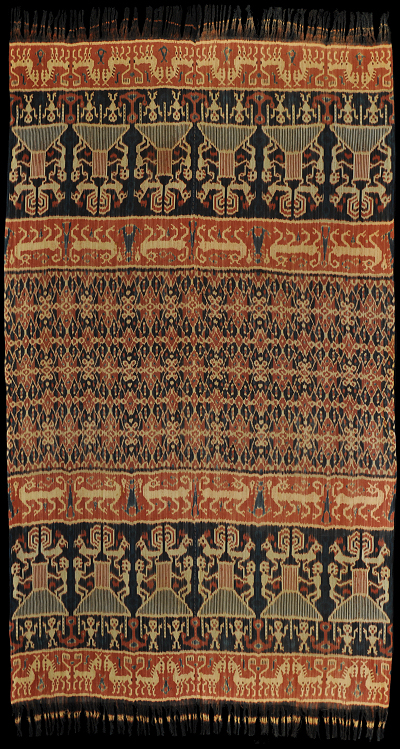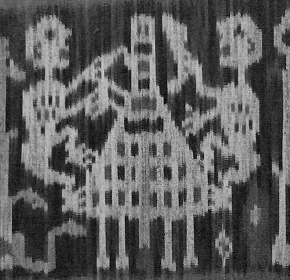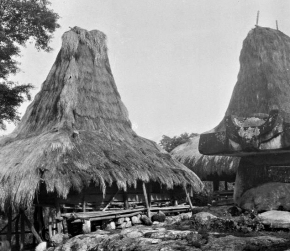| |
 
 | | | |
194 Sumba, East Sumba
Hinggi (men's blanket)  
| | Locale: | Kalu village near Praliu in Kambera, provenance of the example shown in Adams, below, and where, according to Sumbanese source contacted by Georges Breguet, the motif originated. | | Period: | Early 20th C. | | Yarn: | Cotton, hand-spun, extremely fine, double-ply | | Technique: | Weft ikat | | Panels: | 2 | | Size: | 142 x 250 cm (4' 7" x 8' 2") LW: 1.76 | | Weight: | 715 g (25.2 oz), 201 g/m2 (0.66 oz/ft2) | | Design: | Large hinggi in hindu wallah with unusually wide midfield, kundu duku, covered in patola-inspired patola ratu, reserved for the nobility. Top and bottom decorated with a motif rarely depicted on hinggi. It shows the final rites in building a marapu ratu house-temple (a.k.a. uma bokulu), when two wooden ancestor figures, male and female (here sheltered by the structure) are mounted on the roof beam. Men are shown working on the roofs, which are crowned by cockatoos. These sections are separated from the midfield by bands with kucing hutan (wild cats), which serve as wallah keys: for the panels . The ends of the cloth are marked by bands with horses, another mark of nobility, snakes and small fishes. | | Comment: | Historically important hinggi of exceptional quality with very rare design. M.J. Adams in her 1969 analysis of 300 old hinggi in mostly Dutch museums found not a single one showing houses, but did mention one in the Luijendijk collection, and showed one from Kambera in a 1974 article. There is one other known example in the Barbier Mueller Museum. The midfield's patola ratu motif, challenging even for a an accomplished weaver, is uncommonly intricate, showing the hand of a master. The uma is both a physical building and the smallest societal unit, a group for which it serves as ritual centre. The absence of a transversely woven border, kabakil, indicates that the piece was never intended to be worn. A few tiny brown stains, probably siri, otherwise in perfect condition. A true pusaka. Ex collection Wassing-Visser. | | Background: | Chapters on Sumba and East Sumba. | | Exhibited: | Hong Kong University Museum and Art Gallery, 2017. | | Published: | Ikat Textiles of the Indonesian Archipelago, 2018.
Ikat from Timor and its Outer Islands, 2022.
Noble Virtuosity: Hidden Asymmetry in Ikat from Sumba, 2024. | | Compare: | 193 027 061 062 | | Sources: | Very similar to old hinggi from Kambera depicted in Adams, Symbols of the Organized Community in East Sumba, Fig. 6. An early 20th c. hinggi likewise showing houses under construction but with very different tonality in the Barbier Mueller Museum is shown in Breguet, From Cotton to Cloth. Close-up shows the roof similarly being worked on by clan members, though without supervision by cockatoos and no ancestor figures:

Photo below shows Sumba houses in early 20th. C. Photo Tropenmuseum.
 | | |

©Peter ten Hoopen, 2024
All rights reserved.
|
|


